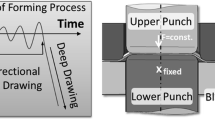Abstract
The function of a press is to transfer one or more forces and movements to a tool or die with the purpose of forming or blanking a workpiece. Press design calls for special knowledge of the production process to be used. Depending on the intended application, the press is designed either to execute a specific process or for mainly universal use.
Access this chapter
Tax calculation will be finalised at checkout
Purchases are for personal use only
Preview
Unable to display preview. Download preview PDF.
Similar content being viewed by others
Bibliography
Anselmann, N. (editor): Europäisches Recht der Technik, Beuth Verlag, Berlin, Vienna, Zurich (1993).
ANSI B11.1-1971: Safety requirements for the construction, care, and use of mechanical power presses, American National Standards Institute Inc., New York (1971).
Becker, U., Ostermann, H.-J.: Wegweiser Maschinenrichtlinie, Bundesanzeiger-Verlag, Cologne (1995).
Bodenschatz, W., Fichna, G., Voth, D.: Produkthaftung, Maschinenbau-Verlag, Frankfurt/Main, 4th edition. (1990).
DIN EN 692 (Draft): Mechanische Pressen - Sicherheit, Beuth Verlag, Berlin (1992).
DIN EN 693 (Draft): Hydraulische Pressen - Sicherheit, Beuth Verlag, Berlin (1992).
DIN EN 1037 (Draft): Sicherheit von Maschinen, Trennung von der Energiezufuhr und Energieabbau, Vermeidung von unerwartetem Anlauf, Beuth-Verlag, Berlin (1993).
Hoffmann, H., Schneider, F.: Schwingen verhindert-Hydraulische Zieheinrichtung für die Fertigung mit hoher Qualität in einfachwirkenden Pressen, Maschinenmarkt 95 (1989) 51/52.
Hoffmann, H.: Vergleichende Untersuchung von Zieheinrichtungen, Bänder Bleche Rohre (1991) 12 and (1992)1.
Kürzinger, F.-X.: Kraftneutrale Parallelregelung über gesamten Hub, Bänder Bleche Rohre (1995) 9.
Occupational Safety and Health Administration: OSHA Regulations 29 CFR Ch XVII, Part 1910, Office of the Federal Register, Washington D.C., 7-1-92 Edition (1992).
Schmidt, K.: Die neue Druckbehälterverordnung, WEKA Fachverlag, Augsburg (1995).
Schwebel, R.: Geringe Parallelitätsabweichungen - Anwendungsspektrum hydraulischer Pressen, Industriebedarf (1994) 9.
Süddeutsche Metall-Berufsgenossenschaft: Unfallverhütungsvorschriften, Carl Heymanns Verlag KG, Luxemburg (1994).
TÜV Hannover-Sachsen-Anhalt: Kurzinformation EG-Maschinen-Richtlinie, Eigenverlag (1995).
Author information
Authors and Affiliations
Consortia
Rights and permissions
Copyright information
© 1998 Springer-Verlag Berlin Heidelberg
About this chapter
Cite this chapter
SCHULER GmbH. (1998). Fundamentals of press design. In: Metal Forming Handbook. Springer, Berlin, Heidelberg. https://doi.org/10.1007/978-3-642-58857-0_3
Download citation
DOI: https://doi.org/10.1007/978-3-642-58857-0_3
Publisher Name: Springer, Berlin, Heidelberg
Print ISBN: 978-3-642-63763-6
Online ISBN: 978-3-642-58857-0
eBook Packages: Springer Book Archive




